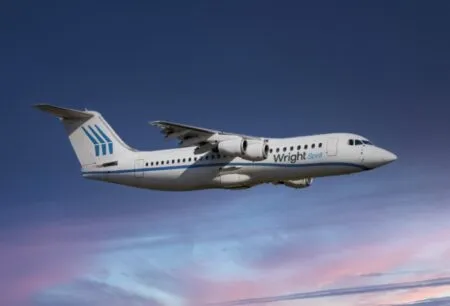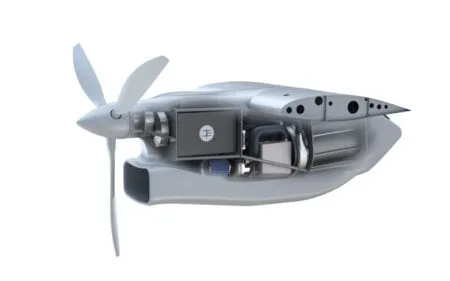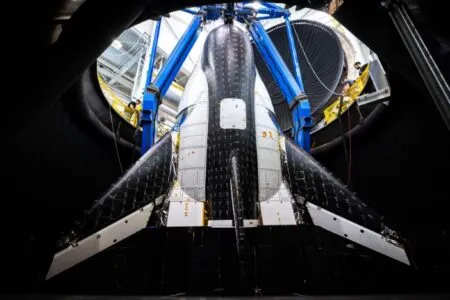A vision of an artificial intelligence piloted business jet was presented to the world last October by Embraer, while in recent years autonomous piloting in specific circumstances has become a reality. Two companies, Cirrus and HondaJet now offer an autonomous flight feature for emergencies. For several years before these recent developments, the aviation industry had been debating reduced or no pilot operations.
While airlines and their passengers may offer resistance to artificial intelligence (AI) controlled aircraft, the freight market has seen demonstrations of unmanned drones over non-long-haul routes. However, for the business jet sector the only customer that needs to be convinced is the high net worth individual or corporation.
How many prospective private owners of business jet class aircraft would rather not need to learn to fly or pay for pilots?
Embraer has decided that whoever the final decision maker is for acquiring an AI-enabled business jet, it is going to stake its claims in the market. The unnamed three-cabin-zone medium cabin jet concept revealed at last year’s NBAA Business Aviation Convention and Exhibition (BACE) by the Brazilian aircraft OEM was a fully autonomous jet with a sustainable propulsion system fueled by green hydrogen, sustainable aviation fuel (SAF), or Lithium-ion batteries.
According to Embraer nothing has been defined or worked on with the aircraft since. For the company, the unnamed autonomous aircraft was presented as an idea. The company said: “The concept aircraft shows the boundaries of what is possible and the potential future innovations. Most importantly, we showed the video to inspire the industry to continue innovative thinking. At this point, there are no commitments from Embraer Executive Jets to develop and manufacture the aircraft.”
But work elsewhere continues on the building blocks that could lead to the business jet Embraer has proposed. A significant building block is Autoland, also called Safe Return. This safety feature is already offered on the Cirrus Aircraft Vision Jet and will soon be available on the Honda Aircraft Company’s HondaJet Elite II.
The former aircraft is a single engine jet, the latter has two. Flying up to four occupants, the 40ft (12m) wingspan HondaJet Elite II has a maximum cruise speed of 485mph (782km/h), a range of 1,780 miles (2,865km) and a maximum altitude of 43,000ft. Like Embraer’s concept jet, the Elite II was also announced at NBAA-BACE 2022 last October.
At its HondaJet Elite II announcement, Honda said: “With the announcement of its journey of automation, Honda Aircraft Company also plans to introduce Autothrottle and Emergency Autoland by the end of 2023.”
According to the company, it wants to enhance operational safety and reduce pilot workload through “automation, augmentation, and situational awareness technologies.”
It is such a drive to greater automation, augmentation and other technologies that are the stepping stones that could lead to an autonomous aircraft.
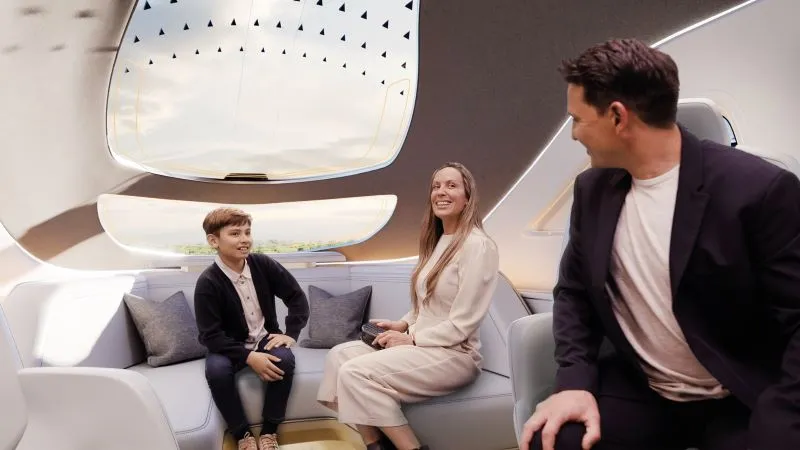
Autonomous flight
“Autonomous flight is on our mind. There are a lot of associated technologies, and the technology is almost ready,” said Cirrus Aircraft Vision Jet product line executive director, Matthew Bergwall. “We are definitely keeping it in mind, but there are regulation changes that have to occur and public acceptance issues.” In January 2019, Cirrus Aircraft introduced its Generation 2 (G2) version which has Autothrottle. This integrates with the autopilot and can automatically adjust the aircraft’s speed for each phase of flight, giving the pilot more time to focus on other tasks.
Cirrus announced its Autoland feature, Safe Return, in 2019. Safe Return was developed as part of a collaboration with the aviation technology company Garmin International. During that announcement, Cirrus Aircraft CEO Zean Nielsen said, “Safe Return delivers the next step towards autonomous flight.”
When activated, Safe Return takes control of the aircraft and turns the Vision Jet into an autonomous aircraft. It navigates to the nearest suitable airport for landing, communicates with air traffic control, lands and brings the aircraft safely to a complete stop. Autothrottle is a key enabling building block for Safe Return.
The 39ft (11.8m) wingspan Vision Jet can carry a maximum of seven passengers that can cruise at 350mph (560km/h). Its maximum altitude is 31,000ft and its range is 1,470 miles (2,365km).
Safe Return is activated by an easily accessible button in the ceiling of Vision Jet’s passenger section. Once pushed the computer takes over. Bergwall says, “It calculates the weather that’s out there, any storms or bad weather and tries to figure out how to navigate around it. It figures out where to go with the terrain. There is also how busy the airport is.”
According to Bergwall, a major airport is not necessarily going to be its first choice. The computer might select somewhere, “a little bit further away or smaller. It will land in a major airport such as Atlanta if you absolutely need to, but it will look at some other options first. From there it will create a route.”
“It will also contact air traffic control on both the frequency for that sector for ATC and the emergency frequency as well. The computer’s role is simplified because under aviation rules, in an emergency the pilot has the right
of way.
“This capability was on Garmin’s radar for some time, and I know there were a lot of different technology building blocks that went into getting the technology to market,” says Bergwall.
Safe Return was certified in August 2020 on the Vision Jet. “It was an active project for us for at least a year and a half, prior to the October 2019 announcement date,” adds Bergwall. Without Garmin, Cirrus would not have Safe Return but without the G2 aircraft, Garmin would not it in the market either, he points out.
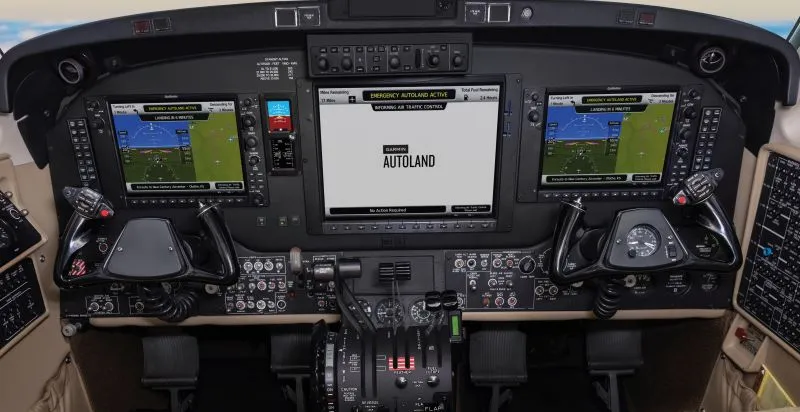
cockpit of a single engine jet (Image: Garmin)
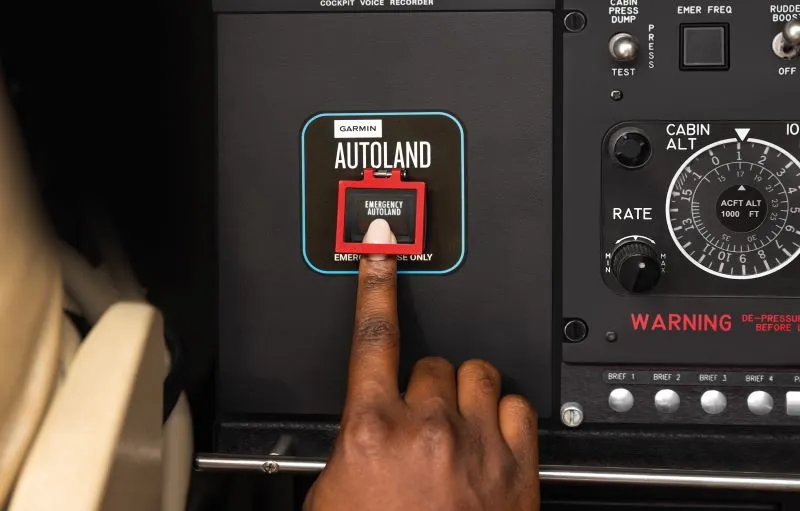
Avionics software
Autoland is compatible with the six-seat single-engine turboprop Piper M600 SLS and the Daher TBM 940, another single-engine turboprop, as well as the Vision Jet and HondaJet Elite II. Garmin’s G3000 flight deck provides Safe Return, which Garmin calls Autoland. The initial flight testing for Autoland began in May 2014 and its software and hardware development began many years before this. Eventually, Autoland’s first certification was on the Piper M600 in May 2020.
Garmin states that Autoland was developed with the vision that it would be available to use on a variety of aircraft. Each aircraft has different requirements and Garmin worked closely with the aircraft manufacturer to address those requirements using the provisions built into Garmin Autoland. For example, each aircraft model has unique messaging for passengers after the system is activated.
According to Garmin, several technologies were key to the development of Autoland, “but one of the biggest challenges was bringing them together in a practical manner”, the company says.
The firm was able to leverage many existing technologies within its integrated flight deck products, such as the autopilot, navigation capabilities, communication capabilities and other systems needed to fully control the aircraft to landing. One requirement added for the G2’s Safe Return capability was a radar altimeter for the landing portion. But elsewhere the aircraft retains its normal suite of safety systems, including Automatic Dependent Surveillance –Broadcast (ADS-B) and Terrain Collision Avoidance System.
Garmin’s Autoland won the prestigious 109-year-old Robert J Collier Trophy in 2021, which recognizes outstanding aeronautical technical developments. It is the world’s first certified autonomous system designed to activate during an emergency to safely fly and land an aircraft without human intervention.
Another company that is working to transform what avionics can do is Massachusetts’ Merlin Labs. Its Merlin Pilot is an AI that is in development with the USA’s Department of Defense.
“There is no certified aircraft out there today that can go from a standing still start on a runway, autonomously takeoff, go fly a mission and autonomously land without a human in the loop,” says Merlin Labs CEO and founder Matt George.
“We have a really important partnership with the US Department of Defence that we have talked about quite a bit publicly, particularly around taking the Merlin pilot and applying it to the Lockheed Martin C130J Super Hercules transport aircraft.”
Another firm working on an AI-pilot is the Californian company XWing, which is developing its Superpilot product. Superpilot is currently being certified. The company is initially targeting the air freight sector for the AI-enabled pilot.
Superpilot is not entirely autonomous and is managed remotely. The XWing mission control and ground crew staff monitor Superpilot flown aircraft and intervene if necessary. This operating model is close to that used by the Department of Defense for its drones, where pilots fly missions from Air Force bases in the USA using aircraft that are based in a foreign territory with its own maintenance crew.
Merlin Labs is still focused on certifying basic “foundational autonomy” and then adding cognitive skills like natural language processing on top. The natural language and cognitive skills of the Merlin Pilot will enable it talk to ATC.
“For learned behaviors like natural language, we feed the system thousands of hours of audio and other examples to be able to train the model,” George explains.
The model will not just recognize speech but know how to act upon instructions. Merlin wants its AI to be capable of replying to air traffic control requests, “so that the controller can talk to the aircraft just like they would talk to any other traditionally-crewed aircraft”, says George.
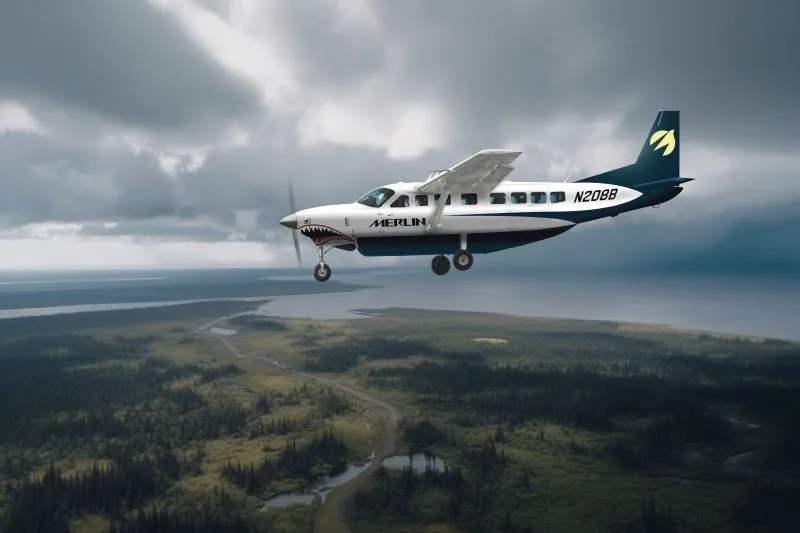
However, such functionality for business jets may be some way off. “We have not announced any plans to roll it out yet,” says George. “But you can imagine a future world where Merlin will be able to complement human crews on larger business aviation aircraft.”
Embraer has declared that its autonomous concept is just that, a concept, and there are no development programs behind the scenes, but other companies are working towards that vision. The building blocks, radar altimeter, Autothrottle and sufficient computation to make choices between weather and terrain, have all been put in place. The likes of Merlin Labs and XWing will one day deliver a fully autonomous pilot. Then it will be up to the customer, do they want an autonomous business jet, or would they prefer to see a confident smile from a human pilot?



